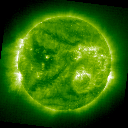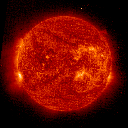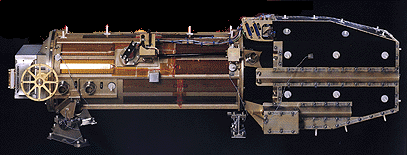![[instrument]](images/EIT_logo_title.gif)
The SOHO Extreme ultraviolet Imaging Telescope
brought to you by
EIT data analysis proposal form
A Web form (for those with Web viewers that support forms) can be used to
submit a proposal to
analyze EIT data. Please note, however, that there are some
restrictions on proposals prior to
1996 September 15.
![[New]](../icons/new.gif) EIT observing plan for tomorrow
EIT observing plan for tomorrow
The SOHO observing
plan for tomorrow includes EIT subfield target coordinates and areas,
image times and wavelengths, and formal observing campaigns.
EIT science topics
At its 1996 March meeting, the
EIT
Consortium decided to list some initial research topics as well as
volunteers from the consortium to lead the initial efforts in each area.
These are not meant to be exclusive or to indicate permanent rights
of any sort, but it would benefit any prospective Guest Investigator (official
or otherwise) to contact one of the Consortium members whose names are
associated with a topic of interest to the Guest Investigator. The list can be
thought of as the initial framework for the EIT Bulletin Board of proposed
research.
The science topics list can be found here.
Current solar images from EIT

 The image on the left was obtained in the Fe XII emission line at 195 Å,
while that on the right was obtained in He II 304 Å. Fe XII (eleven-times
ionized Fe) is common at temperatures of 1.5 million K; He II is formed
primarily at 60,000 - 80,000 K.
The image on the left was obtained in the Fe XII emission line at 195 Å,
while that on the right was obtained in He II 304 Å. Fe XII (eleven-times
ionized Fe) is common at temperatures of 1.5 million K; He II is formed
primarily at 60,000 - 80,000 K.
The times at which these images were obtained are available on the SDAC
"current
solar images" page.
While the pixel scale of the EIT instrument is
1024 x 1024 2.6-arc second pixels, the images to which these thumbnails are
linked has been reduced to 512 x 512 to keep the file size reasonable (160 -
200 Kbyte).
New:The LASCO/EIT interim synoptic observing program
The LASCO/EIT synoptic oberving program to be
run for ~ 2 months starting on 1996 May 14 describes the C1, C2, C3 and EIT
"time slots" in the daily plan. As can be seen from inspection of the plan,
very little time is available for EIT high-cadence observations.
EIT data rights policy
The EIT Consortium has released its data rights
policy to clarify when and how access to EIT data will be available to
non-Consortium members.
What EIT is designed to do
The SOHO EIT is able
to image the solar transition region and inner corona in four, selected
bandpasses in the extreme ultraviolet (EUV):
- Fe IX/X, 171 Å
- Fe XII, 195 Å
- Fe XV, 284 Å
- He II, 304 Å
Using either full-disk or subfield images, the EIT can image active regions,
filaments and prominences, coronal holes, coronal "bright points," polar
plumes, and a variety of other solar features. The instrument was designed to
be used in conjunction with other
SOHO
instruments, particularly the
LASCO visible-light coronagraphs and the
SUMER and
CDS imaging spectrographs, as well as with ground-based instruments.

The EIT is a normal-incidence, multilayer telescope of novel design.
A paper describing the instrument (Delaboudinière et al. 1996,
Solar Physics 162, 291) is available in
dvi,
PostScript,
or Adobe pdf
form.
Access to full-resolution EIT images
EIT Consortium members can access full-resolution, GIF images in all four
wavelengths here.
Response: updated daily
The mean counts per unit time in full-field EIT images in each of the four
sectors are plotted from the beginning of operations. Note that 304 Å
appears to show the greatest change with time, and with bakeout.
Bakeouts so far: 1996 May 23 - 25, 1996 June 23 - 24.
After the second bakeout, the 304 Å signal appears to be very similar
to the signal after the first bakeout. Given the shorter duration of the second
bakeout (~ 24 hours vs. ~ 48), this may be considered evidence to support the
model that we are seeing the effects of water ice condensing on the
detector.
Plots are available for:
Engineering: EIT temperature plots
The most recent plots of:
At the 1996 March meeting of the EIT Consortium, the Consortium members
agreed on a data rights policy to encourage
the "widest possible access to and analysis of the EIT data consonant with the
rights of the team members whose dedication and expertise made the instrument
a reality."
EIT science planning schedule
EIT science planners serve for four weeks (plus a few days). We have a
tentative schedule for the next
several months.
The EIT Operations Team at NASA Goddard Space Flight Center
- Joe Gurman,
NASA/GSFC, Co-I
-
Elaine Einfalt, Hughes STX, Ground Systems Manager
- Jeff Newmark, Applied Research Corp., Team Scientist
- Barbara Thompson, Applied Research Corp., Team Scientist
Send mail to:
 The SDAC home page
The SDAC home page
 The SOHO home page
The SOHO home page
Web curator:
Joseph B. Gurman
Responsible NASA official:
Joseph B. Gurman,
Facility Scientist, Solar Data Analysis Center
joseph.b.gurman@gsfc.nasa.gov
+1 301 286-4767
NASA Goddard Space Flight Center
Solar Physics Branch / Code 682
Greenbelt, MD 20771
Last revised - J.B. Gurman
![[instrument]](images/EIT_logo_title.gif)

 The image on the left was obtained in the Fe XII emission line at 195 Å,
while that on the right was obtained in He II 304 Å. Fe XII (eleven-times
ionized Fe) is common at temperatures of 1.5 million K; He II is formed
primarily at 60,000 - 80,000 K.
The image on the left was obtained in the Fe XII emission line at 195 Å,
while that on the right was obtained in He II 304 Å. Fe XII (eleven-times
ionized Fe) is common at temperatures of 1.5 million K; He II is formed
primarily at 60,000 - 80,000 K.